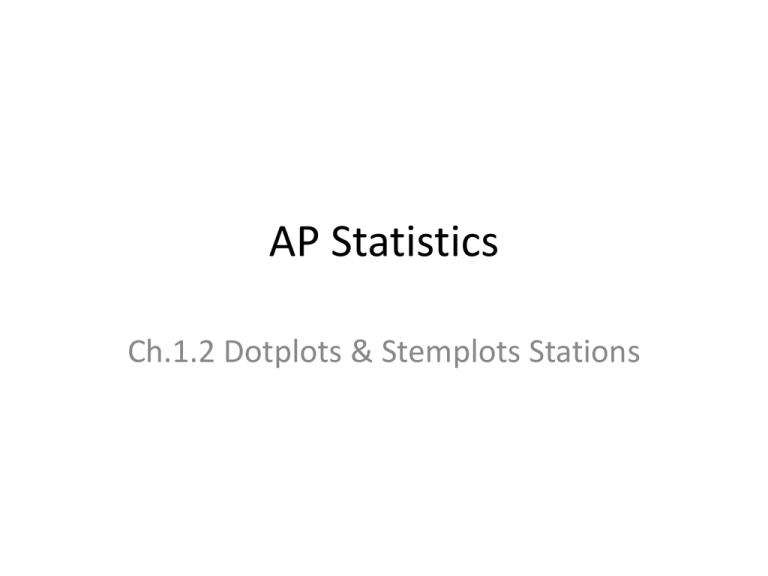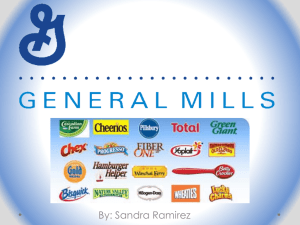Here
advertisement

AP Statistics Ch.1.2 Dotplots & Stemplots Stations Station 1: Dotplots 1. Make a dotplot of the # of hours of sleep AP Statistics students at ChiArts got the night before the first day of school. Describe what you see (hint: use SOCS). Hours of sleep: 6 2. 7 6 4 7 7 5 3 4 6 3 6 7 5 5 Researchers collected data on 77 brands of cereal at a local supermarket. For each brand, the sugar content (grams per serving) and the shelf in the store on which the cereal was located (1=bottom, 2=middle, 3=top) were recorded. A dotplot of the data is shown below. Compare the three distributions. Critics claim that supermarkets tend to put sugary kids’ cereals on lower shelves, where the kids can see them. Do the data from this study support that claim? Station 1 Solutions 1. 2. The distribution of hours of sleep is skewed left; more AP Statistics students at ChiArts get 6-7 hours of sleep than 3-4 hours of sleep. (no outliers) The median number of hours of sleep is 6, with a range of 4 hours. • • • • • • • • • • • • • • • 3 4 5 6 7 The distributions of the top & bottom shelf cereals are skewed right, while the distribution of the middle shelf is skewed left. (no outliers) The top shelf has a median sugar content of 6 grams, the middle shelf 12 grams, and the bottom shelf 3 grams. On all three shelves, the range of sugar content in cereals is 15 grams. Based on these observations, it appears the claim is partially true. The middle shelf does have cereals with the most sugar. Howeer, the bottom shelf has more cereals with very little sugar and the top shelf has many cereals with a wide range of sugar values. Station 2: Compare Stemplots 1. The U.S. Food and Drug Administration (USFDA) limits the amount of caffeine in a 12-ounce can of carbonated beverage to 72 milligrams. That translates to a maximum of 48 milligrams of caffeine per 8ounce serving. Data on the caffeine content of popular soft drinks (in milligrams per 8-ounce serving) are displayed in the stemplot below. a) Why are the stems split? b) Give an appropriate key for this graph. c) Describe the shape, center and spread of the distribution. Compare the caffeine content of these drinks with the USFDA’s limit. 2. We asked the students in a large first-year college class how many minutes they studied on a typical weeknight. Here are the responses of random samples of 30 women and 30 men from the class: a) Examine the data. Why are you not surprised that most responses are multiples of 10 minutes? Are there any responses you consider suspicious? b) Make a back-to-back stemplot to compare the two samples. Does it appear that women study more than men (or at least claim that they do)? Justify your answer. Station 2 Solutions 1. (a) If we had not split the stems, most of the data would appear on just a few stems. (b) Key: 2|3 means that an 8-ounce serving of that soft drink has 23 mg of caffeine. (c) Somewhat skewed right. The center is 28 mg and the values range from 15 to 47 mg. All these drinks meet the USFDA’s limit. 2. a) Not only are most responses multiples of 10, but many are multiples of 30 and 60.Most people will round their answers when asked to give an estimate like this. The students who claimed 360 minutes (about 6 hours) and 300 minutes (about 5 hours)may have been exaggerating. (b) Yes; the approximate centers are 175 minutes for women and 120 minutes for men. Station 3: Histogram Preview 1. Returns on common stocks The return on a stock is the change in its market price plus any dividend payments made. Total return is usually expressed as a percent of the beginning price. The figure below shows a histogram of the distribution of the monthly returns for all common stocks listed on U.S. markets from January 1985 to September 2007 (273 months).28 The extreme low outlier represents the market crash of October 1987, when stocks lost 23% of their value in one month. (a) Ignoring the outliers, describe the overall shape of the distribution of monthly returns. (b) What is the approximate center of this distribution? (c) Approximately what were the smallest and largest monthly returns, leaving out the outliers? (d) A return less than zero means that stocks lost value in that month. About what percent of all months had returns less than zero? 2. Shakespeare The histogram below shows the distribution of lengths of words used in Shakespeare’s plays.29 Describe the shape, center, and spread of this distribution. Station 3 Solutions 1. (a) The distribution is slightly skewed to the left. (b) Answers will vary. The center is between 0% and 2.5%. (c) The highest return was between 10% and 12.5%.Ignoring the low outliers, the lowest return was between −12.5% and −10%. (d)About 37% of these months (102 out of 273) had negative returns. 2. Skewed to the right with a center of about 4 letters. The smallest word contains 1 letter and the largest word contains 12 letters, so the range is 11 letters. There are no outliers.











